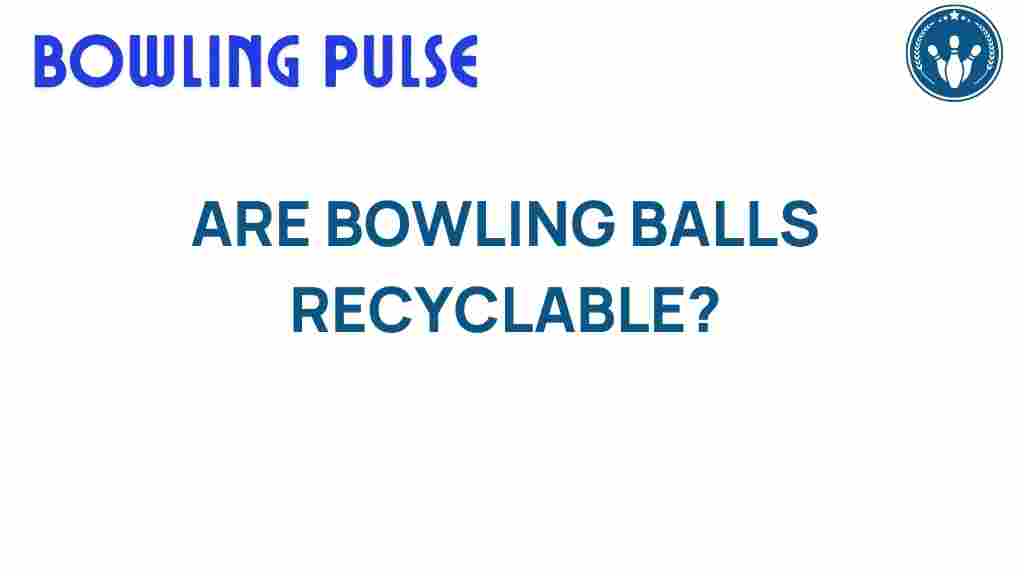Are Bowling Balls Recyclable? Unpacking the Environmental Impact
Bowling is a beloved pastime for many, but as the popularity of the sport grows, so does the concern for the environment. An important question arises: are bowling balls recyclable? In this article, we will explore the sustainability of bowling balls, the materials used in their production, and the impact of waste management in the bowling industry. By understanding these factors, we can make informed decisions that contribute to a more eco-friendly future.
The Materials Behind Bowling Balls
Bowling balls are typically made from several materials, each contributing to their performance and durability. The primary materials include:
- Polyester: Often used in entry-level balls, polyester is lightweight and provides a smooth finish.
- Urethane: A more advanced material that offers better grip and control, making it popular among serious bowlers.
- Reactive Resin: This material provides superior hook potential and is favored by competitive bowlers.
- Plastic: Used primarily for spare balls, plastic offers consistency and durability.
Each of these materials has its own environmental impact, which we must consider when discussing the recyclability of bowling balls.
The Environmental Impact of Bowling Balls
The production and disposal of bowling balls can have significant environmental consequences. Some of the key factors to consider include:
- Resource Extraction: The materials used in bowling balls often come from non-renewable resources, contributing to environmental degradation.
- Manufacturing Processes: The production of bowling balls requires energy and generates waste, which can lead to pollution.
- End-of-Life Disposal: Many bowling balls end up in landfills, where they can take years to decompose.
Understanding these impacts highlights the importance of recycling and sustainability within the bowling industry.
Are Bowling Balls Recyclable?
The short answer is yes, bowling balls can be recycled, but the process is not straightforward. Here’s a step-by-step look at how bowling balls can be recycled:
Step 1: Identify the Material
Before recycling, it’s crucial to identify the material of your bowling ball. Most recycling facilities do not accept all types of plastics, so knowing whether your ball is made of polyester, urethane, or reactive resin can help determine your options.
Step 2: Check Local Recycling Programs
Not all recycling programs accept bowling balls. Check with your local waste management service to see if they have a specific policy for sports equipment. Some areas may have special collections for items like bowling balls.
Step 3: Contact Bowling Alleys
Many bowling alleys have recycling initiatives or can direct you to organizations that accept old bowling balls. It’s worth asking about their waste management practices.
Step 4: Consider Reuse
If your bowling ball is still in good condition, consider donating it to local schools, community centers, or youth bowling leagues. This not only extends the life of the ball but also promotes participation in the sport.
Step 5: Upcycling Options
For those who are creative, upcycling is a fantastic way to give new life to an old bowling ball. Some ideas include:
- Turning it into a garden ornament or planter.
- Crafting a unique lamp or light fixture.
- Creating decorative pieces for your home.
Bowling Industry Initiatives for Sustainability
The bowling industry is becoming increasingly aware of its environmental responsibilities. Here are some initiatives and practices that promote sustainability:
- Eco-Friendly Ball Production: Some manufacturers are beginning to use recycled materials in their bowling balls, reducing the demand for new resources.
- Green Bowling Alleys: Many bowling centers are implementing energy-efficient lighting, water-saving fixtures, and recycling programs.
- Community Engagement: Bowling organizations are encouraging players to participate in clean-up events and sustainability workshops.
Troubleshooting Common Recycling Issues
Even with the best intentions, you may run into challenges when trying to recycle a bowling ball. Here are some common issues and tips for troubleshooting:
Problem: Local Facilities Don’t Accept Bowling Balls
Solution: Look for specialty recycling centers that focus on sports equipment. Websites like Earth911 can help you find local resources.
Problem: The Bowling Ball is Damaged
Solution: Assess the damage. If it’s beyond repair, check if any parts are recyclable. Some components may be accepted separately.
Problem: Uncertainty About Upcycling Ideas
Solution: Search for inspiration online. Pinterest and DIY blogs often feature creative upcycling projects for old bowling balls.
The Future of Bowling Balls and Sustainability
As we move towards a more sustainable future, the bowling industry must adapt to changing consumer preferences and environmental regulations. The focus on recycling and eco-friendly practices is likely to grow, leading to innovations in materials and manufacturing processes.
By participating in recycling and sustainability efforts, bowlers can help reduce the environmental impact of their favorite sport. The bowling community can come together to promote eco-friendly practices, ensuring that the joy of bowling continues for future generations.
Conclusion
In conclusion, bowling balls are recyclable, but the process requires awareness of materials, local programs, and potential reuse options. The environmental impact of bowling balls is significant, but with the right steps, we can mitigate this impact through effective waste management and sustainable practices.
As bowlers, we have a responsibility to consider the sustainability of our sport. By embracing recycling, reusing, and supporting eco-friendly initiatives within the bowling industry, we can enjoy our pastime while also caring for our planet. Together, let’s roll towards a greener future!
For more information on sustainability practices and recycling initiatives, visit this resource.
This article is in the category Culture and created by BowlingPulse Team
